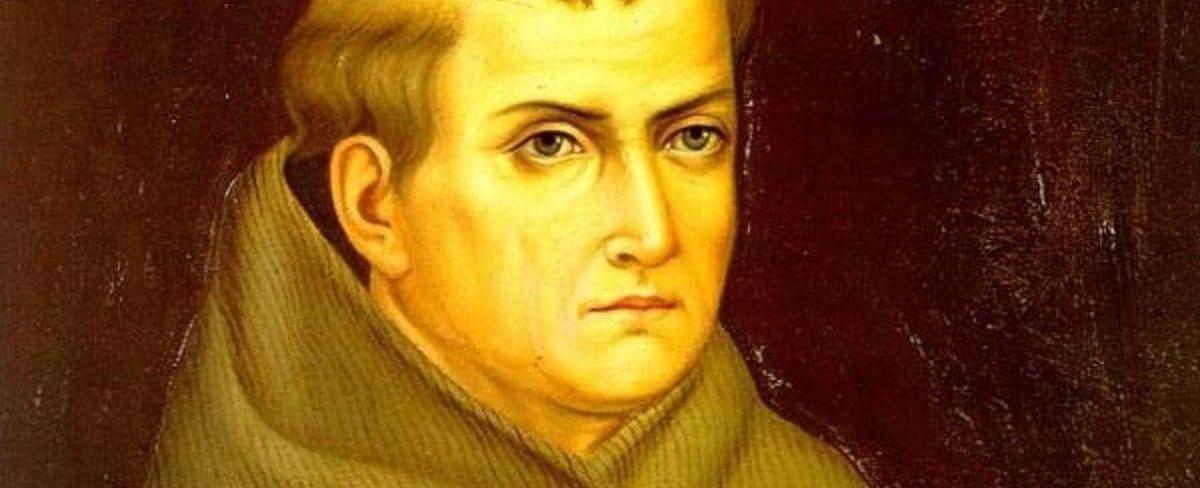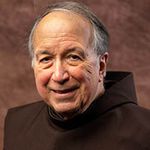Saint Junipero Serra: Apostle of California

On July 1, all Catholics in the United States join Franciscans in celebrating the memorial of Saint Junipero Serra (1713-1774), the "Apostle of California." (Elsewhere, his feast day is August 28, his date of death.)

Statue of Serra in San Diego, California, his first mission in what is now the United States, founded in 1769.
Formed in austere penitential environment
Born Miguel Serra to humble farmers in the village of Petra on the island of Mallorca (Majorca), Spain, he grew up close to a Franciscan friary where he received his elementary education. He entered the Friars Minor at Palma de Majorca in 1730 and was given the name Junipero after one of the early companions of Saint Francis. There he was formed in an austere penitential environment.
Early ministry devoted to teaching student friars
Ordained in 1737, the young Serra was considered brilliant; his early ministry was devoted to educating student friars in philosophy and theology according to the teachings of John Duns Scotus.
A missionary among indigenous peoples of America
In 1749, Serra abandoned his academic career, volunteering for mission work among the indigenous peoples of America. Landing in Veracruz, Serra, faithful to the Rule of Francis, insisted on making the difficult journey to Mexico City on foot; during the hike he suffered a leg wound that would plague him the rest of his life. In Mexico City he was incorporated into the Missionary College of San Fernando. After a year of training, Serra engaged in eight years of mission work among the Pame people in the Sierra Gorda region. Returning to the College in 1758, Junipero was engaged in preaching parish missions and other tasks, but then in 1767 he was placed in charge of the Franciscans who took over the Jesuit missions in Baja California when the latter were expelled from Spanish territory that year.

This illustration is from an early biography of Serra by his long-time companion, Fr. Francisco Palou (1787) (public domain).
Leading the Franciscans north to found missions
Two years later, when the Spanish decided to expand their colonial effort into Alta California, Serra accompanied the Spanish governor, Gaspar de Portolá, arriving in San Diego Bay in July 1769, where he established the first mission, San Diego de Alcalá; the next year he founded Mission San Carlos Borromeo (Carmel) on Monterey Bay, which became his headquarters. As exploration continued, in 1771 two more missions followed: San Antonio and San Gabriel, and in 1772 San Luis Obispo.

Serra's room at Mission Carmel.
Zealous, self-sacrificing leadership
Eventually Serra would found four other missions in Alta California. Despite failing health and great obstacles – especially recurring tensions with Spanish military as well as civil governors – he continued his determined, self-sacrificing leadership until his death at Carmel in 1784, at age 70. At that time, his missions housed some 4,600 ‘neophyte’ Christian Indians. By 1821 the California chain would comprise some 21 missions.

Mission San Carlos Borromeo del Rio Carmelo, near Monterey, California, founded in 1770. Serra made his headquarters here, and this is where he passed away. The present stone church was dedicated in 1797.

Memorial cenotaph to Serra at Mission Carmel dedicated in 1924.
“Keep moving forward”
Serra was beatified in 1988 and canonized by Pope Francis on September 23, 2015, who saw in him a person thoroughly committed to the evangelizing mission of the Church:
Father Serra had a motto which inspired his life and work, a saying he lived his life by: siempre adelante! Keep moving forward! For him, this was the way to continue experiencing the joy of the Gospel, to keep his heart from growing numb, from being anesthetized. He kept moving forward, because the Lord was waiting. He kept going, because his brothers and sisters were waiting. He kept going forward to the end of his life. Today, like him, may we be able to say: Forward! Let’s keep moving forward!

Serra's grave in the sanctuary of the church in Mission Carmel.
Canonization provoked sharp reactions
However, when Serra's canonization was announced in January of that year, it provoked sharp reactions among both scholars and the public, especially regarding his treatment of the indigenous peoples. The Academy of American Franciscan History did publish a solid video introducing the new saint in his historical context. But again, Serra became a polarizing figure during widespread demonstrations in 2020 protesting the historically poor treatment of minorities in United States. In that context, Dr. Robert Senkewicz, co-author of the definitive scholarly biography of Serra, published a very informative video addressing many of these issues. We hope it is helpful.

The most thorough scholarly biography of Serra, by Rose Marie Beebe and Robert Senkewicz of Santa Clara University, published in 2015 shortly before Serra's canonization.
Main image: Portrait of St. Junipero Serra (detail), Santa Bárbara Mission Archive-Library
Dominic Monti, OFM
Professor of Franciscan Research in the Franciscan Institute of St. Bonaventure University
Dominic V. Monti, OFM, is a Franciscan Friar of Holy Name Province (USA) and currently professor of Franciscan Research in the Franciscan Institute of St. Bonaventure University. He devoted the greater part of his ministry to teaching the History of Christianity, in particular the history of the Franciscan movement. He has contributed two volumes to the Works of St. Bonaventure series and is author of Francis & His Brothers, a popular history of the Friars Minor.

